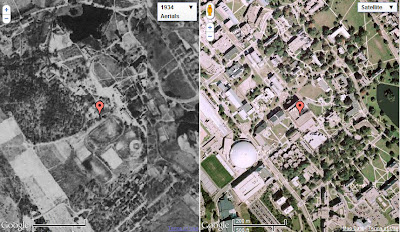This is the fourth in a series of posts on web-based maps developed by the University of Connecticut Libraries Map and Geographic Information Center (MAGIC) for the On The Line project.
Today’s posting on interactive maps showcases the Race Restrictive Covenants in Property Deeds, Hartford area, 1940s, which exemplifies the use of Geospatial technologies in the humanities. Geospatial technology allows us to show historic data in new and interesting ways and enables the user to see the data from a new perspective. Working with Professor Jack Dougherty at Trinity College, MAGIC developed this digital map as part of the On The Line project, a public history of schooling, housing, and civil rights in the Hartford metropolitan region.
Restrictive covenants are barriers — typically against African-Americans, Jews, or Catholics — that were written into property deeds by individual home owners or real estate developers, to legally block them from owning or occupying housing. In 1921, the U.S. Supreme Court affirmed the right of private property owners to insert these restrictions, but when challenged by civil rights organizations such as the NAACP, it eventually ruled in the 1948 Shelley v Kraemer case that these restrictions were no longer enforceable by governmental authority. Yet restrictive language still exist in the legal paper trail of property records. Based on their search of property records in West Hartford, Professor Dougherty and a Trinity student researcher, Katie Campbell, so far have found 5 examples of racial restrictive covenants in suburban housing developments from the early 1940s. Click the map above to see the location of each covenant, with a link to scanned source document.
For example, the developer of High Ledge Homes, located near South Main Street in West Hartford, inserted this restriction when filing the property deed in June 1940:
“No persons of any race except the white race shall use or occupy any building on any lot except that this covenant shall not prevent occupancy by domestic servants of a different race employed by an owner or tenant.”
While students generally learn about the history of segregation in Southern and border states, this map reveals a hidden chapter in our history of the North. Racially restrictive covenants have been extensively documented in other northern cities, such as Chicago, Detroit, and Seattle. In their digital history website, the Seattle Civil Rights and Labor History Project, students and faculty from the University of Washington built community awareness that helped to pass a 2006 state law making it easier for homeowners associations to rid themselves of these historical racial covenants.
Within the Hartford region, can you help us find other examples of restrictive covenants by race, religion, or nationality? Do you recall seeing or hearing about similar barriers in the property deed of a family member or neighbor? If so, please post a comment on the On The Line website or contact MAGIC via email.
Technical Detail:
The cartographic layer for the Race Restrictive Covenants in Hartford area, 1940s: A Map with Linked Documents map was created using ESRI’s ArcMap software. Professor Dougherty and Katie Campbell from Trinity College located housing development deeds in West Hartford, CT containing restrictive language.
Using the deeds, we digitized the location of housing developments that contained restrictive covenants, and then exported the shapefile as a KMZ file using ArcGIS ArcToolbox conversion tool. We then edited the individual pop-up balloons using Google Earth and added HTML code to link PDF documents of the property deeds and to improve the overall display of the data, and then this layer was saved as a KMZ file. This is similar to the customization of the Redlining in Hartford KMZ discussed in a previous blog posting. We also integrated a point file for each housing development with restrictive covenants in West Hartford, CT to enhance the geographic visibility of the five developments.
The linked documents map utilizes the Google Maps JavaScript API V3 and custom javascript code by Ben Spaulding and Thomas Bachant. The interactive map interface overlays our content on a Google Maps interface.
Coming next in this series — Home Value Index in the Hartford Region, 1910-2007: An Animated Time Slider Map















